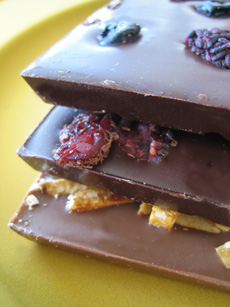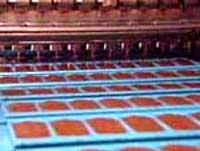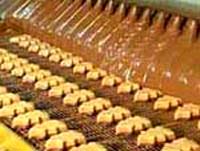 
Artisanal bars from Michael Mischer Chocolates of Oakland, California. Photo by Melody Lan | THE NIBBLE.
|
KAREN HOCHMAN’s first word was not cacahuatl...but as her mother will attest, it was pretty close (coo-cah, or cookie).
|
|
May 2006
Revised January 2009
|
 |
From Pod to Palate: The Birth Of The Bar
Page 9: Making The Chocolate ~ Molding The Chocolate
This is Page 9 of a 10-page article on chocolate production. Click on the black links below to visit other pages.
Making The Chocolate
14. Molding
There are different methods for producing chocolates: enrobing, hollow figure, layer-  and-cutting and molding. Molding is the simples: solid shapes like bars and hearts are poured into molds, as shown at the right. The enrobing process (photo below) is the oldest method for producing chocolates: pre-shaped chocolates centers (caramel, creme, croquant, marzipan, nougat, nuts et al) can be hand-dipped by artisan chocolatiers and further ornamented with fruit pieces, nuts, candied violets, cocoa butter transfer designs or other flourishes on top. In larger operations, the centers are placed on a moving wire mesh belt which takes them to a coating machine. A shower of chocolate falls down to cover the centers in chocolate. Photos of molding (above) and enrobing (below) courtesy of CocoaTree.org. and-cutting and molding. Molding is the simples: solid shapes like bars and hearts are poured into molds, as shown at the right. The enrobing process (photo below) is the oldest method for producing chocolates: pre-shaped chocolates centers (caramel, creme, croquant, marzipan, nougat, nuts et al) can be hand-dipped by artisan chocolatiers and further ornamented with fruit pieces, nuts, candied violets, cocoa butter transfer designs or other flourishes on top. In larger operations, the centers are placed on a moving wire mesh belt which takes them to a coating machine. A shower of chocolate falls down to cover the centers in chocolate. Photos of molding (above) and enrobing (below) courtesy of CocoaTree.org.
 The hollow figure process is used for hollow chocolates (like Easter bunnies) and for chocolates with liquid and semi-liquid fillings. Liquid chocolate couverture is poured into molds; the molds are then rotated so that the excess chocolate can drain away. The thin chocolate layer that sticks to the mold is solidified by cooling. A filling is then dispensed into the mold and covered with another thin layer of chocolate mass. The hollow figure process is used for hollow chocolates (like Easter bunnies) and for chocolates with liquid and semi-liquid fillings. Liquid chocolate couverture is poured into molds; the molds are then rotated so that the excess chocolate can drain away. The thin chocolate layer that sticks to the mold is solidified by cooling. A filling is then dispensed into the mold and covered with another thin layer of chocolate mass.
The layer-and-cut procedure is used for chocolates consisting of various layers such as marzipan, nougat, croquant or fruits. The solid or semi-solid masses are laid on top of another, and after cooling cut into bite-sized pieces, that are often partially or entirely covered with chocolate.
Continue To Page 10: Packaging The Chocolate
Go To The Article Index Above

|





 and-cutting and molding. Molding is the simples: solid shapes like bars and hearts are poured into molds, as shown at the right. The enrobing process (photo below) is the oldest method for producing chocolates: pre-shaped chocolates centers (caramel, creme, croquant, marzipan, nougat, nuts et al) can be hand-dipped by artisan chocolatiers and further ornamented with fruit pieces, nuts, candied violets, cocoa butter transfer designs or other flourishes on top. In larger operations, the centers are placed on a moving wire mesh belt which takes them to a coating machine. A shower of chocolate falls down to cover the centers in chocolate.
and-cutting and molding. Molding is the simples: solid shapes like bars and hearts are poured into molds, as shown at the right. The enrobing process (photo below) is the oldest method for producing chocolates: pre-shaped chocolates centers (caramel, creme, croquant, marzipan, nougat, nuts et al) can be hand-dipped by artisan chocolatiers and further ornamented with fruit pieces, nuts, candied violets, cocoa butter transfer designs or other flourishes on top. In larger operations, the centers are placed on a moving wire mesh belt which takes them to a coating machine. A shower of chocolate falls down to cover the centers in chocolate.  The hollow figure process is used for hollow chocolates (like Easter bunnies) and for chocolates with liquid and semi-liquid fillings. Liquid chocolate couverture is poured into molds; the molds are then rotated so that the excess chocolate can drain away. The thin chocolate layer that sticks to the mold is solidified by cooling. A filling is then dispensed into the mold and covered with another thin layer of chocolate mass.
The hollow figure process is used for hollow chocolates (like Easter bunnies) and for chocolates with liquid and semi-liquid fillings. Liquid chocolate couverture is poured into molds; the molds are then rotated so that the excess chocolate can drain away. The thin chocolate layer that sticks to the mold is solidified by cooling. A filling is then dispensed into the mold and covered with another thin layer of chocolate mass.